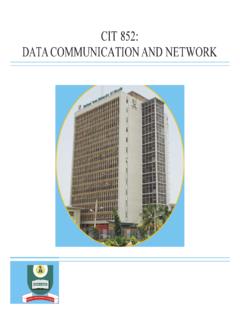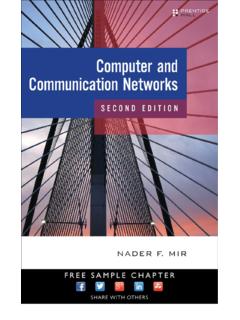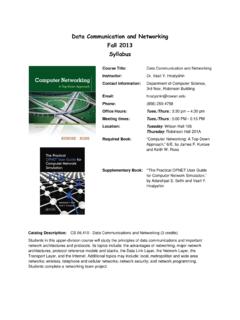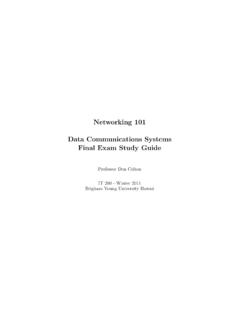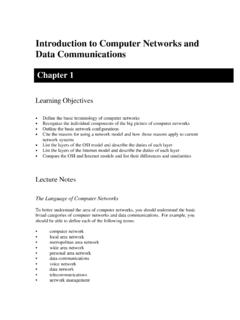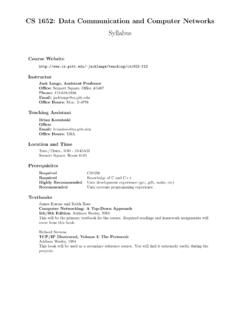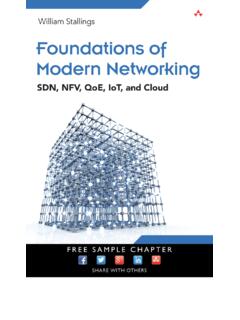Transcription of Short Answer Type Questions Data Communication
1 Maninder Kaur Page Short Answer Type Questions data Communication Q1. Distinguish between attenuation distortion and delay distortion. Ans: Attenuation distortion arises because the attenuation of the signal in the transmitting media. Attenuation distortion is predominant in case of analog signals. Delay distortion arises because different frequency components of the signal suffer different delay as the signal passes through the media. This happens because the velocity of the signal varies with frequency and it is predominant in case of digital signals. Q2. How the effect of delay distortion can be minimized? Ans: Delay distortion can be minimized by using an equalizer (a kind of filter). Q3. What is inter-modulation noise? Ans: When a signal (having different frequency components) passes through a transmitting media, then due to non-linearity, some of the frequency components may combine to generate a different frequency component.
2 This leads to distortion in the signal, which is known as inter-modulation noise. For example, a signal may be having frequency components f1 and f2, and due to non-linearity of the media they may generate a frequency component (f1+f2). Further a frequency of (f1+f2) may be already present in the original signal. This causes inter-modulation noise. Q4. Why does impulse noise have more effect on digital signals rather than on analog signals? Ans: Impulse noise is random in nature and arises due to random events like lightning, electrical sparks, etc. In case of digital signal, it makes a significant effect, as 0 may become 1 and vice versa. In analog signal the effect is not that serious as some portion of the signal gets affected. Q5.
3 What is crosstalk? Ans: Crosstalk refers to the picking up of electromagnetic signals from other adjacent wires by electromagnetic induction. Maninder Kaur Page Q6. Let the energy strength at point 2 is 1/50th with respect to the point 1. Find out the attenuation in dB. Ans: Then attenuation in dB is 10log10(1/50) = - dB. Q7. Assuming there is no noise in a medium of B = 4 KHz, determine channel capacity for the encoding level 4. Ans: I = 2 4000 log24 = 16 Kbps Q8. Why do you need encoding of data before sending over a medium? Ans: Suitable encoding of data is required in order to transmit signal with minimum attenuation and optimize the use of transmission media in terms of data rate and error rate. Q9. What are the four possible encoding techniques? Give examples.
4 Ans: The four possible encoding techniques are Digital data to Digital Signal; Example - Transmitter Analog data to Digital Signal; Example - Codec (Coder-Decoder) Digital data to Analog Signal; Example - Modem Analog data to Digital Signal; Example - Telephone Q10. Between RZ and NRZ encoding techniques, which requires higher bandwidth and why? Ans: RZ encoding requires more bandwidth, as it requires two signal changes to encode one bit. Q11. How does Manchester encoding differ from differential Manchester encoding? Ans: In the Manchester encoding, a low-to-high transition represents a 1, and a high-to-low transition represents a 0. There is a transition at the middle of each bit period, which serves the purpose of synchronization and encoding of data . In Differential Manchester, the encoding of a 0 is represented by the presence of a transition at the beginning of a bit period, and a 1 is represented by the absence of a transition at the beginning of a bit period.
5 In this case, the midbit transition is only used for synchronization. Maninder Kaur Page Q12. How Manchester encoding helps in achieving better synchronization? Ans: In Manchester encoding, there is a transition in the middle of each bit period and the receiver can synchronize on that transition. Hence better synchronization is achieved. B8ZS coding is preferred over Manchester encoding for long distance Communication ? Ans: The B8ZS encoding is preferred over Manchester encoding, because B8ZS encoding requires lesser bandwidth than Manchester encoding. Q14. Why is it necessary to limit the band of a signal before performing sampling? Ans: It is necessary to limit the bandwidth of a signal before sampling so that the basic requirement of sampling theorem, the sampling rate should twice or more than twice the maximum frequency component of the signal is satisfied.
6 This is known as Nyquist rate. If it is violated, original signal cannot be recovered from the sampled signal. Q14. Distinguish between PAM and PCM signals? Ans: In order to convert Analog data to Digital signal, initially sampling is done on the analog data by using Sample & Hold (S/H) circuit. The output of the S/H circuit is known as PAM (Pulse Amplitude Modulated) signal. The PAM signal is then converted to PCM Q15. Why analog-to-analog modulation technique is required? Ans: Analog-to-analog modulation is required to achieve the following goals: Use of higher frequency for efficient transmission through a media Possibility of sending more than one signal through a media simultaneously through FDM (Frequency Division Multiplexing) technique. Use of smaller antenna size Q16.
7 What are the possible analog-to-analog modulation techniques? Ans: Three possible analog-to-analog modulation techniques are: Amplitude modulation Frequency modulation Phase modulation Maninder Kaur Page Q17. Between AM and FM, which one gives better noise immunity? Ans: FM is more immune to noise than AM, since the power of transmission is independent of the modulation index. Q18. What are the possible digital-to-analog modulation techniques? Ans: Three possible digital-to-analog modulation techniques are: Amplitude Shift Keying (ASK) Frequency Shift Keying (FSK) Phase Shift Keying (PSK) Q19. Why PSK is preferred as the modulation technique in modems? Ans: In PSK scheme it is possible to send a signal having more than one digital value. The approach is known as Quadrature PSK.
8 Q3. Out of the three digital-to-analog modulation techniques, which one requires higher bandwidth? Ans: For a given transmission bandwidth, higher data rate can be achieved in case of PSK. In other words, in PSK higher channel capacity is achieved although the signaling rate is lower.



